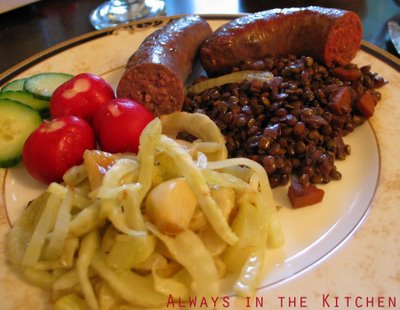 Yesterday, we went to Gibsons to have a family dinner at my sister's house. It was in part a belated Father's Day event, for which I made cookies, in part a very much belated Easter gathering, and all around a fine excuse to sit in the sun, drink beer and chat, and eventually fire up the grill for a little supper.
Yesterday, we went to Gibsons to have a family dinner at my sister's house. It was in part a belated Father's Day event, for which I made cookies, in part a very much belated Easter gathering, and all around a fine excuse to sit in the sun, drink beer and chat, and eventually fire up the grill for a little supper.Well, I was too ill-prepared and, let's face it, downright greedy to take a picture of the fantastic grilled chicken that I had for dinner last night, but I am thrilled that I was given a jar of Pat's homemade spice rub that transported ordinary chicken breasts into a spicy, delicious, brag-worthy meal. Of course, the homemade foccacia, the freshly picked garden salad greens, and the nugget potatoes roasted with onions and garlic all contributed their fair share, but the chicken, with it's little bath of olive oil and quick rub with this fragrant, heady mixture, was undoubtedly the star of the show.
I'm not entirely sure what goes into it. I'm reasonably confident that garlic granules and cayenne pepper play a significant role, but I am told that there are upwards of 14 or 15 different spices required to make the spice rub. It's worth it.
 We also managed to score a bag of the garden greens, which went into today's lunch of BLTs on sourdough bread. There's enough left over for a good dinner salad, so tomorrow's menu is well under construction.
We also managed to score a bag of the garden greens, which went into today's lunch of BLTs on sourdough bread. There's enough left over for a good dinner salad, so tomorrow's menu is well under construction.Switching topics slightly, on a recent foray out of our usual dinner haunts, we found ourselves wandering down 4th Avenue on our way to get some tandoori chicken. En route, we paused outside a trendy little joint that has recently changed its name. We wondered if it had changed ownership, too, so we sidled over to look over the glassed-in menu posted outside. One of the few customers, an unhappy-looking woman sitting next to the open window, pursed her lips and shook her head slightly. We looked at the menu to see the same sort of ambitious combinations that had been so poorly executed in its last incarnation, and decided that the ownership was probably the same. I glanced back at the customer, sitting with a posture of regret and one hand on an empty wineglass, and she again shook her head. She made direct eye contact, shook her head, then closed her eyes and sighed, lifting her eyebrows slightly... a clear warning off. I gave her a little tight nod, and a thumbs-up, and she smiled, briefly. We continued on to our original destination.
I hope her evening improved - I hope it was a little bit improved by the fact that someone took her silent advice. We probably wouldn't have gone in, but it was nice to have our suspicions confirmed. Whoever you are, thank you.
















